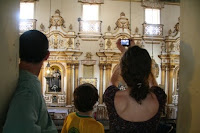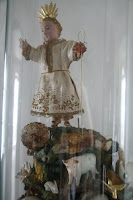


We arrived in Salvador, Brazil, on a humid, hot morning. It took my camera lens awhile to adjust from the ship's air-conditioning to the new environment.
The captain's perch, extended out for entering and leaving ports, is visible from our balcony.
It always takes a couple of hours for the ship to clear immigration. During this time, we usually have a diplomatic briefing from a US Embassy Foreign Service Officer, who talks about the country we are visiting, gives any warnings, and also talks to the students about careers in the foreign service.
To gain access to the country, sometimes we have face-to-face immigration, meaning all 800 of us need to personally take our passport to the immigration officers for a stamp. Other times, like here in Brazil, the immigration officers process our passports and visas without us personally presenting them. After a couple hours of processing, we were cleared to go--and the skies had cleared, too.
We walked down the port street--deemed by Charis and Barek to be the stinkiest of all port streets!--to the Mercado Modelo, a market center that today sells trinkets for tourists, but in Brazil's past was a center for selling slaves.



Just beyond the market is the city elevator that connects the Lower City with the Upper City. A trip up or down one of the elevators costs only a few cents. Once in the upper city, we looked back down below.



The square in front of the elevator was cobblestone, as was most of the upper city, which is home to the older sections of Salvador. The government building in the second photo was under construction. Just beyond these buildings was the bank where I used the ATM upon arrival in Salvador. I later came to find out that although the bank machine gave me money on that first visit, someone had rigged the machine to read cards and steal their pin numbers. Days later, we discovered that someone had used my card number (I still have the physical card in my possession) seven times to withdraw a grand total of $2000. This happened to everyone on our ship who used that machine. After I get back home and go through the long dispute process, I'm sure I'll get my money back, but unfortunately this and many other incidents colored our picture of Salvador. A very large number of people from our ship--students, lifelong learners and crew members--were mugged, some at knife point. A group of students was even beaten by the police! A huge number of muggings happened in the first hour or two off the ship and the news spread like wildfire amongst us. This turned out to be, by far, our most dangerous port. Luckily, although some had worse experiences than others, everyone survived their time and made the best of it. Aside from the ATM issue, our family didn't have any other problems.




If you look closely in the first photo, you can see our ship in the water beyond the buildings. We stopped by this large cross sculpture to look back towards the ship.




The first day was a holiday and many things weren't open. We had to wait until the next day to visit the Basilica Cathedral in the second and third photos and the Church of St Domingos across the way in the final photo.




The buildings were painted in lively colors. The second photo is of the Afro Brazilian Museum and the final photo is once again St Domingos. One would think with the military hanging around with submachine guns that crime wouldn't be such an issue!




After walking past St Domingos, we headed down a side street and were delighted to find a music video being filmed. We think we were in a bit of it!




The cobblestone streets with the colorful buildings were delightful. Of course, the theatre sign caught my eye and we soon learned that the premiere dance group of Brazil was housed there.




There are two Churches of St Francis, side by side. The larger one, in the first photo, was not initially opened, so we went into the smaller church (third photo) and were delighted by the beauty and unique statuary.




The Church of the Third Order of St Francis, as it is known, has a hall of saints that refreshingly includes many of the black saints.
We explored all over the church, including upper areas and a lovely courtyard.
Some of the statues were more graphic than others! In many of the churches, we noticed a lovely custom of miniatures encased in glass. The final photo shows the Christ child on a hill with animals; we saw several of these charming statues during our time in Salvador.


We were walking through the streets when rain clouds gathered and it absolutely poured. Luckily this lovely restaurant was nearby; we hustled in and stayed until the rain had passed. We have barely had any rain during our entire semester--so we did not mind this shower at all.


After lunch and the rain, we went to this overlook point to see some of the rest of the city.

We went back to the main St Francis Church--known as the "Gold Church". The interior is absolutely breathtaking. Although photography is not allowed in the church, somehow this photo magically appeared in my camera!



After a short rest on the ship, we headed back out. By this time, so many people had been mugged, that many decided to not go out at all that evening. We decided to brave it and headed back to the upper city and got caught in a rainstorm. We ducked into this tiny cafe where the kids ordered Guarana, a tasty soda made from a Brazilian fruit. The drink is kind of like a cherry creme soda. Steve and I ordered a local beer, which was served absolutely ice cold. All beer is kept nearly frozen it seems and served from large bottles which are placed in mini-coolers on the table. They do not want that beer to get warm!




We passed this barbershop, and although the streets seemed a bit deserted, we found a great pizza place where some fellow SASers stopped by to say hi.




We headed down another rather lonely street back to the theatre where we saw the most wonderful Capoeira and other Brazilian folk dances. This professional company was outstanding and put on an amazing show that we will not soon forget. Capoeira originated as a martial art brought by African slaves to Brazil. The slaves would fight each other for entertainment, but would also train in Capoeira as a potential means of being able to defend themselves and possibly attack others. Slave owners of course did not approve of Capoeira for obvious reasons. And so when the slaves would be practicing Capoeira and the masters would come around, the slaves would change the martial art into a dance, pretending that they were simply dancing, not fighting. The art evolved into what it is today: a beautiful dance that involves fight moves that just miss the opponent. The group we saw performed several different kinds of dance, including dances with fire, wooden weapons that chipped under the force of the blows and steal weapons that sparked when they made contact. All five of us really enjoyed this exciting show.
We were very glad we had braved the night. We caught a cab back to the ship and arrived home safe and sound.
Here are some video clips of the Dance Video being filmed and a short clip of the Fire Dancer at the performance we saw:













No comments:
Post a Comment